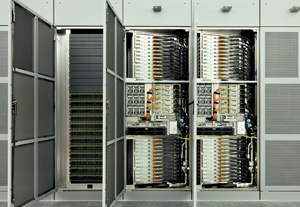Sep. 6, 2013 RIKEN Places Computing / Math
Charting the future of supercomputing
Based at the RIKEN Kobe campus, the Advanced Institute for Computational Science is the home of the K computer, one of the fastest supercomputers in the world.
 © 2013 RIKEN
© 2013 RIKEN
Supercomputers have become essential for research and development in science and engineering due to their ability to simulate complex systems in areas as diverse as molecular dynamics, drug discovery and climate prediction.
In 2002, Japan first led the world in supercomputing technology with the Earth Simulator. Five times faster than its nearest competitor, the Earth Simulator held the top spot for five consecutive editions of the TOP500 list, a biannual list of the most powerful supercomputer systems in the world. Four years later under an initiative by the Japanese government designating supercomputing as a key technology of national importance, RIKEN was chosen to spearhead the construction of a new supercomputer and, in 2010, established the Advanced Institute for Computational Science (AICS) in Kobe to oversee its management.
The K computer—the AICS’s core facility—became fully operational in September 2012 and is made up of 864 racks with a total of 88,128 interconnected central processing units. It is named after the Japanese word kei, which represents the term 10 quadrillion or 10 peta, a one followed by 16 zeros, in honor of its speed: the K computer is the first computer in the world to have achieved a speed of 10 peta floating point operations per second (FLOPS). Remarkably, it is approximately 293 times faster than the original Earth Simulator.
The K computer has already garnered many accolades. In 2011, the computer was twice recognized as the world’s fastest by the TOP500 list, and the Gordon Bell Prize for outstanding achievement in high-performance computing was awarded to a group comprising researchers from RIKEN, the University of Tsukuba, the University of Tokyo and Fujitsu who used the K computer to perform simulations on the electronic states of 100,000 atoms within silicon nanowires.
A major objective of the AICS is to improve the science of forecasting by using large-scale simulations performed on the K computer to generate predictions of fundamental relationships in nature. This effort focuses on five crucial areas identified by the Japanese government—namely the life sciences, global climate and natural disasters, materials and energy, industrial innovation and the origin of matter and the Universe.
With a budget of 9.7 billion yen for the 2012 fiscal year, the AICS currently employs 182 members of staff including 43 women, 13 foreign researchers and 5 PhD students. To nurture the next generation of scientists and further extend its community outreach, the institute offers summer schools and seminars to postgraduate students and young researchers to assist them in taking advantage of supercomputing technologies.
Now that the K computer is fully operational, the AICS continues to create innovative projects that challenge its star machine. By utilizing the K computer’s overwhelming capabilities, the AICS is looking forward to pushing Japan to the forefront of computational science, and enhancing the nation’s position as a beacon upon which researchers from around the world can converge to expand their research horizons.
